The Intel SSD 600p (512GB) Review
by Billy Tallis on November 22, 2016 10:30 AM ESTATTO
ATTO's Disk Benchmark is a quick and easy freeware tool to measure drive performance across various transfer sizes.
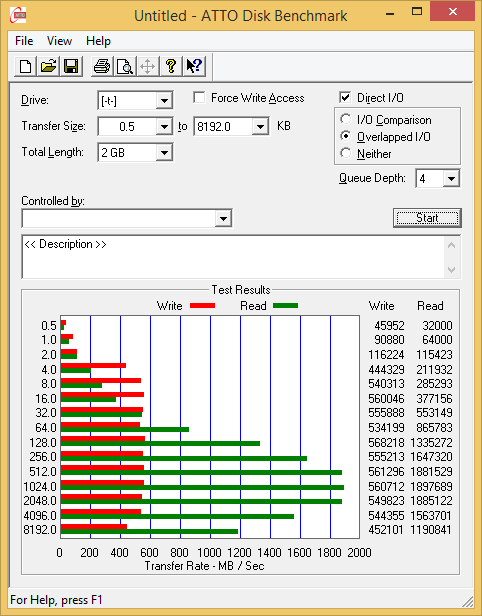 |
|||||||||
Both read and write speeds fall off toward the end of the ATTO test, indicating that thermal throttling is starting to happen. When limited to PCIe 2.0 x2, the performance is somewhat variable and does not show any clear signs of thermal throttling.
AS-SSD
AS-SSD is another quick and free benchmark tool. It uses incompressible data for all of its tests, making it an easy way to keep an eye on which drives are relying on transparent data compression. The short duration of the test makes it a decent indicator of peak drive performance.
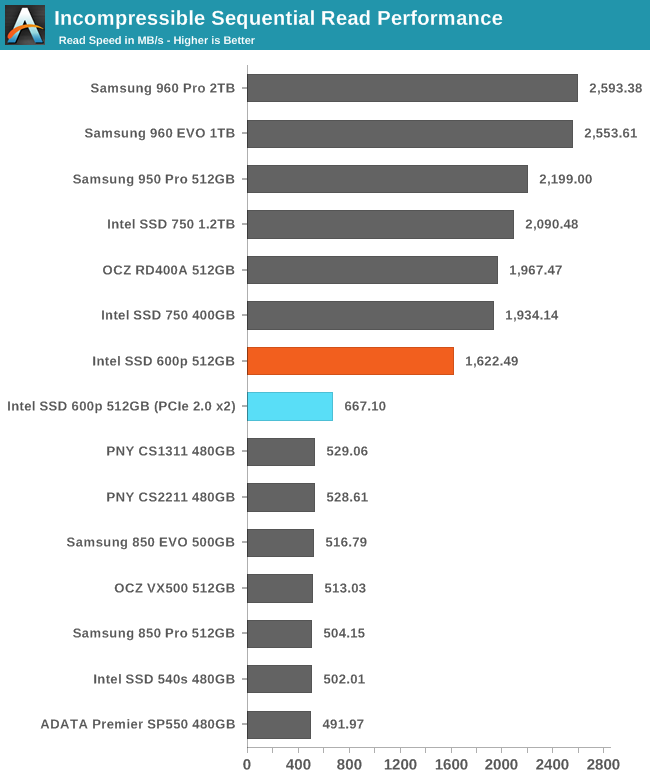
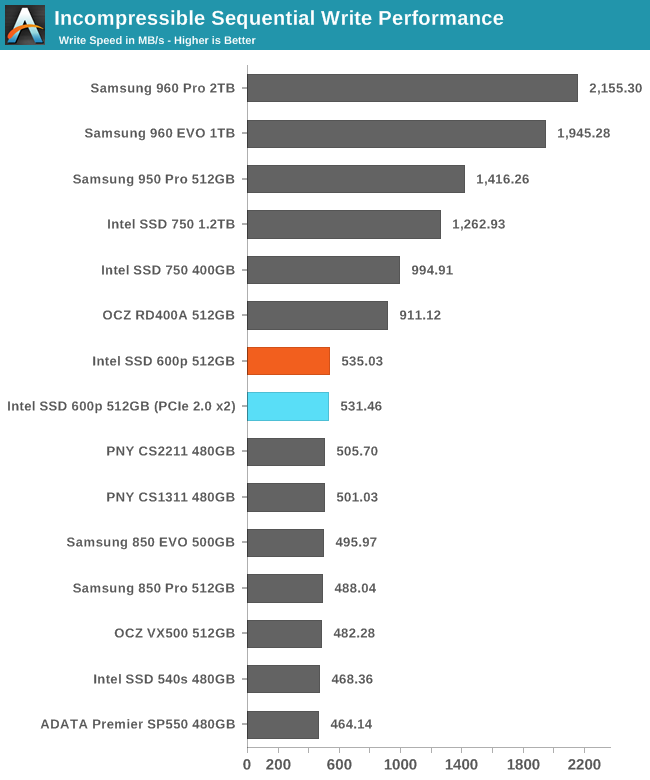
On the short AS-SSD test, the 600p delivers a great sequential read speed that puts it pretty close to high-end NVMe drives. Write speeds are just a hair over what SATA drives can achieve.
Idle Power Consumption
Since the ATSB tests based on real-world usage cut idle times short to 25ms, their power consumption scores paint an inaccurate picture of the relative suitability of drives for mobile use. During real-world client use, a solid state drive will spend far more time idle than actively processing commands.
There are two main ways that a NVMe SSD can save power when idle. The first is through suspending the PCIe link through the Active State Power Management (ASPM) mechanism, analogous to the SATA Link Power Management mechanism. Both define two power saving modes: an intermediate power saving mode with strict wake-up latency requirements (eg. 10µs for SATA "Partial" state) and a deeper state with looser wake-up requirements (eg. 10ms for SATA "Slumber" state). SATA Link Power Management is supported by almost all SSDs and host systems, though it is commonly off by default for desktops. PCIe ASPM support on the other hand is a minefield and it is common to encounter devices that do not implement it or implement it incorrectly. Forcing PCIe ASPM on for a system that defaults to disabling it may lead to the system locking up; this is the case for our current SSD testbed and thus we are unable to measure the effect of PCIe ASPM on SSD idle power.
The NVMe standard also defines a drive power management mechanism that is separate from PCIe link power management. The SSD can define up to 32 different power states and inform the host of the time taken to enter and exit these states. Some of these power states can be operational states where the drive continues to perform I/O with a restricted power budget, while others are non-operational idle states. The host system can either directly set these power states, or it can declare rules for which power states the drive may autonomously transition to after being idle for different lengths of time.
The big caveat to NVMe power management is that while I am able to manually set power states under Linux using low-level tools, I have not yet seen any OS or NVMe driver automatically engage this power saving. Work is underway to add Autonomous Power State Transition (APST) support to the Linux NVMe driver, and it may be possible to configure Windows to use this capability with some SSDs and NVMe drivers. NVMe power management including APST fortunately does not depend on motherboard support the way PCIe ASPM does, so it should eventually reach the same widespread availability that SATA Link Power Management enjoys.
We report two idle power values for each drive: an active idle measurement taken with none of the above power management states engaged, and an idle power measurement with either SATA LPM Slumber state or the lowest-power NVMe non-operational power state, if supported.
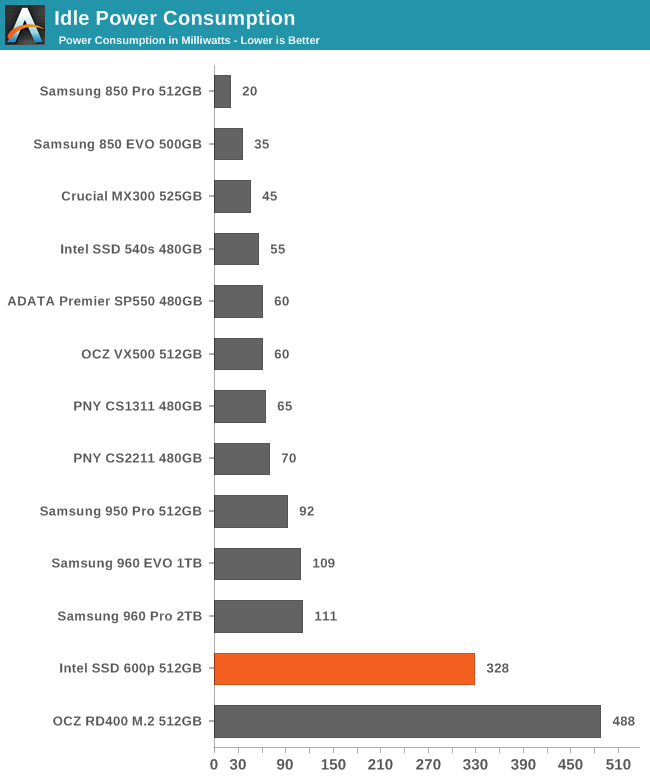
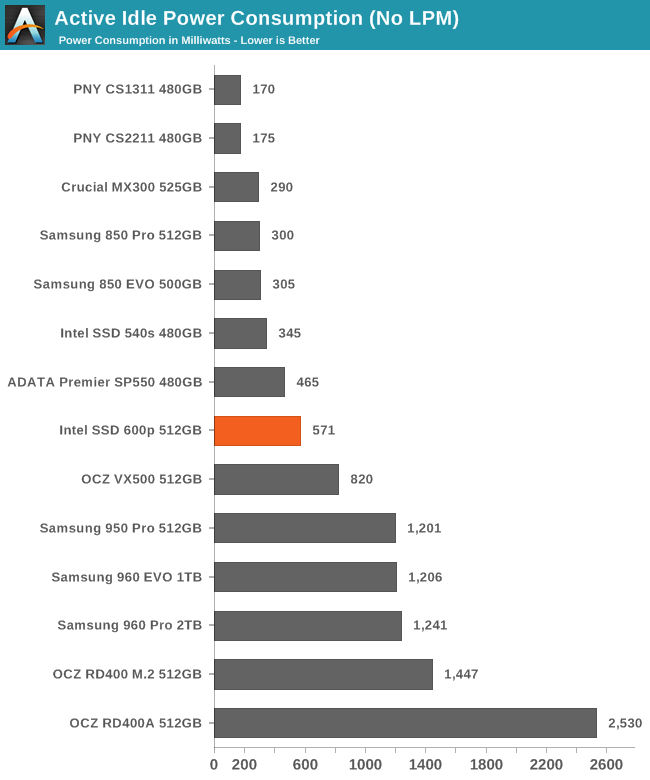
Silicon Motion has made a name for themselves with very low power SSDs. The SM2260 used in the Intel 600p doesn't really keep that tradition alive. It does support NVMe power saving modes, but they don't accomplish much. The active idle power consumption without NVMe power saving modes is much better than the other PCIe SSDs we've tested, but still relatively high by the standards of SATA SSDs.










63 Comments
View All Comments
Billy Tallis - Tuesday, November 22, 2016 - link
The old firmware. The testbed has been too busy with PCIe SSDs lately for me to have a chance to put the November MX300 update through its paces.seanmac2 - Wednesday, November 23, 2016 - link
I would never intentionally buy this product but it bothers me anyway because laptops advertise things like "512 GB PCIe SSD" and I'm left wondering if I'll get this or something sweet like a Samsung 950/951/960.ddriver - Wednesday, November 23, 2016 - link
You get what you pay for. The 600p will likely go into budget products, which won't be CPU powerhouses which may be limited by the sdd performance. Most applications, even prosumer grade software, shows like 1-2$ improvement from going sata to nvme, and this particular product, although technically nvme is more in the sata ballpark.Flying Aardvark - Friday, November 25, 2016 - link
That's why Intel products cost more than others. You do get what you pay for. Intel SSDs have the industry's best reliability, which matters most when your drive fails prematurely. Unlikely if using M.2 you'll see any real world difference between the 600P and anything else.The true step up is the heavy duty Intel 750 stuff with heatsink and zero throttling concerns under heavy, sustained load.
Meteor2 - Wednesday, November 23, 2016 - link
A suggestion: you could link to the previous reviews of devices the first time you mention them, e.g. the 850 Evo. Would save hunting around for them/encourage more page views a people read those reviews before coming back.Meteor2 - Wednesday, November 23, 2016 - link
So where's this drive falling down compared to the other NVMe drives? Is it the TLC NAND, the construction of the dies, the controller, or something else?DominionSeraph - Wednesday, November 23, 2016 - link
"1750MB/s sequential read", and not a single test showing if it could actually reach 1750MB/s sequential read in any real life tasks.Great job there.
beginner99 - Wednesday, November 23, 2016 - link
WTF is this? It's another useless TLC crap drive. Intel, your ruining your reputation and brand with crap like this. I don't see why I should buy this over a MX300 or similar crappy TLC entry level ssd that is even cheaper.Flying Aardvark - Friday, November 25, 2016 - link
Everything is going to be 3D TLC soon except the truly next-level stuff like the Intel 750. 3D TLC is not planar TLC.creed3020 - Wednesday, November 23, 2016 - link
Billy, when are these results going to be included in Bench? I was hoping to compare to my Crucial MX100 but cannot find these Intel drives under SSD2015.